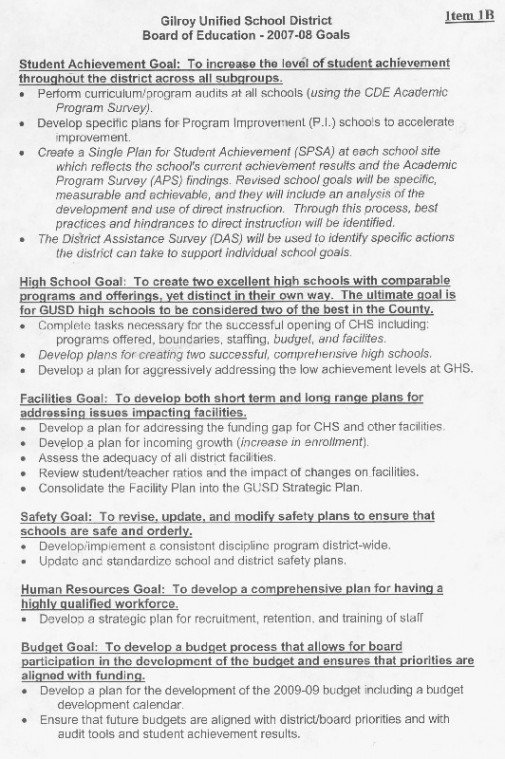Although adding the goal of
”
narrowing the achievement gap
”
would only lengthen a 400-word board priorities list by four
words, school trustees are divided on whether to include the
phrase
– despite more than two hours of discussion at two board
meetings.
Gilroy – Although adding the goal of “narrowing the achievement gap” would only lengthen a 400-word board priorities list by four words, school trustees are divided on whether to include the phrase – despite more than two hours of discussion at two board meetings.
Gilroy Unified School District trustees at a Sept. 20 board meeting were split over whether they should explicitly make reducing the achievement gap – or the disparity among students in varying socioeconomic and ethnic groups on standardized tests – a board goal. The debate, continued from a Sept. 6 board meeting, separated trustees largely into two camps – those that wanted the phrase included and those that worried that including the phrase would encourage administrators and district staff to siphon funding and effort from programs aimed at high achievers to feed programs aimed at low-achievers.
“I think this (list as written) has got everything in it that we need,” board president Tom Bundros said, pointing to the lead phrase, “Increase the level of student achievement throughout the district across all subgroups.”
“We’re trying to accelerate the learning for the kids that are behind,” he added.
Bundros, joined by trustees Rhoda Bress and Denise Apuzzo, expressed concern that an explicit mention of closing the achievement gap could encourage district employees to ignore high-achieving students while paying more attention to low-achieving students in hopes of diminishing the disparity in their test scores.
Funding decisions at schools, such as Brownell Middle School, where Apuzzo’s child goes to school, already reflect such a strategy, she said.
“Last year my child was in accelerated science and this year they’re not offering it,” she said. “When programs are cut, it’s very often that it’s from the accelerated or the average students.”
Holding advanced students stagnant or bringing them down while hoisting up low-achievers is not the way the district closes the achievement gap, said Assistant Superintendent of Educational Services, Basha Millhollen.
“It’s keeping the high-achievers steady, constant and achieving and moving up and taking the low-achievers” and accelerating the low-achievers so they catch up, she said.
Trustees Jaime Rosso and Javier Aguirre, citing similar logic, were flabbergasted at the resistance to include “narrowing the achievement gap” in the board priorities.
“We all recognize the importance of narrowing the achievement gap, but we’re not willing to put it as a goal for the next two to three years,” Aguirre asked rhetorically.
During the discussion, it became apparent to trustees that they differed not only in their expectations of how the achievement gap would be reduced, but also of what the achievement gap was.
“Which gaps are you talking about?” trustee Pat Midtgaard asked Aguirre “If we look at our results, there are gaps all over the place. Are we addressing all of them or one specific one? Does it have to do with language or is it socioeconomic? Is it ethnicity?”
Trustees Rosso and Aguirre and district staff said gaps between the average student and English language learners and socioeconomically disadvantaged students were most pressing.
However, trustees agreed that they needed more information before they approve the board goals. They unanimously directed Superintendent Deborah Flores and her staff to bring the list back at their next board meeting, Oct. 4, with a fuller definition of what the achievement gap is and how the district plans to close it. The board will then vote on the final list, possibly with a phrase addressing the achievement gap, in that meeting.
The lack of consensus as to whether to include an achievement gap phrase should not be construed as trustees attempting to neglect certain student groups, but rather making sure one group is not nourished at another group’s expense, Bress said.
“The achievement gap is one of our most critical issues in public school education today,” she said. “But at the same time … we are here to represent our entire community. We do have other gaps as well and other areas of academic achievement that we want to address.”
This strain between nourishing different student groups long predates the two September debates, Bress added.
“We have a history in this district that we cannot ignore,” she said. “That history is that we have had different groups feeling like their needs haven’t been met … when decisions have been made that affected one group or another. We need to rise above that mentality.”














